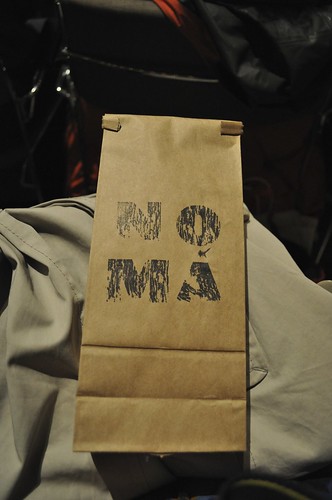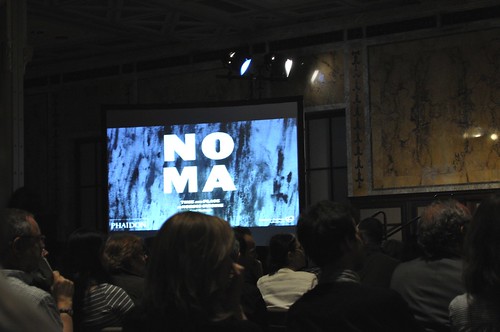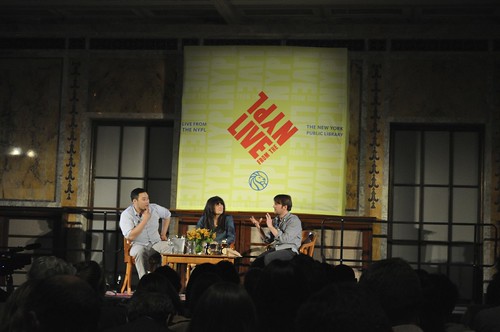
"Eating Culture" aimed to discuss "what makes a cuisine," "what it means to taste a culture's culinary environment," and "the identity of place." This lecture was opportunely scheduled a day before the New York City Wine and Food Festival kicked off.

Inside Stephen A. Schwarzman Building within Celeste Bartos Forum, where the lecture took place.

As parting gifts for all lecture attendees, Chef Redzepi left these crisp, brown paper bags filled with what he referred to later as "old, shitty vegetables." These so-called vegetables include "vintage carrots" and other local vegetables as well as sea vegetables and wild kiwi from Maine. Details about these items to follow.
Before the lecture began, there was a brief introduction from Flash Rosenberg, the Artist-in-Residence at LIVE from the NYPL. More specifically, she is a live-action cartoonist who "creates situational portraits using images, words, and whimsy." She discussed her role at LIVE from the NYPL, explaining "how ideas are drawn (by her) as they are discussed in real time." She concluded this introduction with an animated conversation portrait from a prior year lecture entitled "A Day at el Bulli," with Ferran Adrià in conversation with Harold McGee and Cory Kummer. This was a nice segue into this year's food-related lecture ("Eating Culture"). Please watch the brief animation when you get a chance!
When the featured conversation started, Ruth Reichl began with how Chef Redzepi takes the approach of "understanding food" (with contrast to Chef Adrià, whose conversation portrait, mentioned in this summary by Eater NY, told the audience that "you can't and shouldn't worry about understanding his food"). Chef Redzepi elaborated by saying that while it is important to know about technique (e.g., how to cook a carrot) and prices, but the question to really ask is what is the food we have at hand (e.g., "What is a carrot?"). He then proceeded to stand up and asked each audience member to take the carrot out of the goodie bag. As instructed, I took it out of the bag and took a pretty puzzled look at it. It was probably the ugliest carrot I've ever seen. He suspected the audience would react this way, so he told us that this was a "vintage carrot" (i.e., just a very old carrot)--it was meaty with a caramelized texture and flavor. This was, of course, shocking as the carrot was quite aged.

Chef Redzepi went on to emphasize that the Nordic region of Europe does not have a wide variety of local ingredients at hand. Chef Chang reiterated by saying that Noma is the prime example of how ingredients can put limitation on what you can cook and how learn to make the best of that. He added that New York has everything, that we sometimes take it for granted as we don't think twice about the abundance of ingredients we have at our easy disposal. This led into a discussion of creating an American cuisine (as the common question is, "What is American cuisine?"), an American food culture.

Ruth Reichl transitioned the conversation in asking Chef Redzepi, "What is a restaurant?" He responded in saying that the "act" of a restaurant involves diners, servers, and chefs--all things great food needs to be surrounded by. Strip tablecloths, and there will be an emphasis on people and ingredients, he said. Ruth Reichl came back to say that Chef Redzepi seems to be reevaluating the relationship between the customer and the kitchen. Chef Chang even made another point that the chefs at Noma not only serves the food to patrons (deliberately so) but they also picked the ingredients as well. Chef Redzepi emphasizes this practice, he said, in order to promote commitment and awareness of those working in his kitchen as well as making the dining experience of the patrons part of the staff's experience.

During the next part of the lecture, Chef Redzepi showed the audience a series of videos that demonstrated the hard work (foraging, picking, harvesting) on part of him and his staff to build the kitchen's menu using the scarce (but very rich and interesting) ingredients available in the Nordic region near Copenhagen. Part of the plating and presentation at Noma is that they present the courses as it would appear in nature (e.g., root vegetables served in a terra cotta pot, an egg plated in a "nest," asparagus that tied to a spruce branch and smoked in the oven). While many have criticized his entrées look "too landscape-y," it shows how much thought Chef Redzepi put behind each one of his courses. At one point, the conversation got a little crazy:
Chef Redzepi: Even New Yorkers can start foraging.I feel like a lot of things may have gotten lost in translation, but it was still a very enjoyable lecture. But anyway, Chef Chang said during his time over in Copenhagen with his Momofuku staff, they foraged with Chef Redzepi, and his initial impression was that "it was like eating grass." But later he learned, Chef Chang continued, that Noma excels in execution, discipline, camaraderie, and tenacity as a restaurant.
Chef Chang: Where? In Central Park?
Chef Redzepi: Why not? Foraging brings us back to nature. Back in Copenhagen, we forage a lot of beach plants, which are rich with nutrients from sea water. It's like we're going back to see what the Vikings ate before their journey to plunder England.
One of the last conversations on stage (summarized to the best of my ability from my notes, of course):
Ruth Reichl: So how do you make pay?Might I also add another tidbit (and probably the most memorable moment that night) that got lost in translation (as summarized by Ruth Reichl in her blog summary of the event): when Chef Redzepi pointed out that "chefs would make great terrorists, because they’re so single-minded and obsessed."
Chef Redzepi: Oh yeah -- I forgot about that. It's going to be more expensive as the preparation of our courses are more labor intensive than expected. For the first time, professional chefs are in nature, picking our own herbs and ingredients.
Chef Chang: I'm just trying to make tasty food. I'd like young cooks to learn the respect of the trade and a sense of ownership as well as to cultivate camaraderie in the kitchen.
Findings: I found this conversation to be very informative about Chef Redzepi's now well-renowned restaurant as well as Nordic cuisine in general. Up until the lecture that night, I wasn't really sure what Nordic cuisine consisted of or what Chef Redzepi actually served at Noma. It was truly amazing seeing all of his signature courses offered at his restaurant documented in a series of video clips (some seen in Frank Bruni's article on the Danish chef). To be able to see the labor and dedication involved in preparing and plating of each dish was breathtaking. The discussion about national identity relating to cuisine wasn't all that exciting to me--while the questions of what is truly American cuisine or even what makes a national cuisine are certainly still out there (who knows if it'll ever be resolved or reconciled), the issue is not at all new. What I did find interesting about this particular discussion of these issues, however, was how Chef Redzepi has taken a lead in trying to define Nordic cuisine. His unconventional approach in foraging, plating, and presentation is arguably one of the reasons why Noma was named #1 this year. Also, as a fan of Ruth Reichl, it was nice to finally see her at a talk (last time I had tried to see her at a TimesTalk lecture with Kim Severson, Julie Powell, and Rachael Ray, she had unfortunately broken her leg and couldn't make her way to New York -- Nora Ephron had taken her place).
Price point: $25 for general admission.
--October 6, 2010
New York Public Library
Live from the NYPL
on Fifth Avenue between 40th and 42nd Street
http://www.nypl.org/events/live-nypl

No comments:
Post a Comment